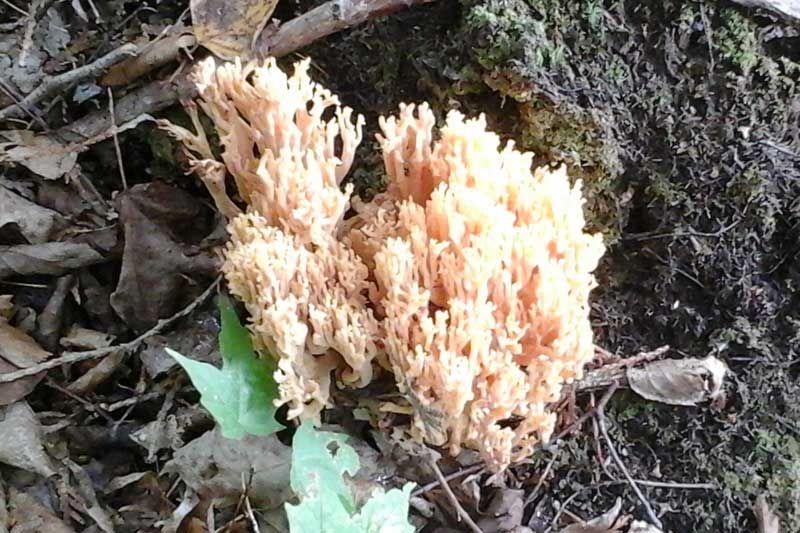Lorraine Julien | Sep 24, 2015
Fall is certainly the best time of the year to spot Fungi growing in the woods, especially after a rainfall when all kinds of fungi seemingly pop up through the wet leaves almost overnight. Of course, you’ll find fungi in other areas but forested areas provide ideal conditions with a good supply of damp, decaying material on which the spores can grow.
Welcome to the world of mushrooms, which is part of the huge group of organisms called fungi. Some fungi are pretty, others are ugly, some can be deadly if eaten, but they are all interesting. Fungi are defined by their inability to make their own food. They thrive on dead or dying matter such as rotting tree trunks and fallen logs and branches. No matter what type of fungus you come across, they are all helping Mother Nature to speed up the decay process by turning dead or dying material into soil.
There are countless types of wild fungi but I will just mention a few I’ve seen recently. A couple of weeks ago, I came across pretty clumps of Golden Clavaria growing on rotting birch logs. They are fairly common so you probably have seen them as well. This fungus is quite easy to spot as it literally seems to suddenly appear among fallen leaves and the bright colour is eye catching. The clumps can be up to 6” wide and about 5” tall. I think they look very similar to some types of coral except that Clavaria is soft and could be easily crushed if you stepped on a clump. I did read somewhere that this fungus is edible but I certainly wouldn’t eat it!
Another common (though not very pretty) fungus is “Black Knot Fungus” which is a black, lumpy and ugly growth that grows on the twigs and branches of choke cherry trees (live ones as well as dead ones). I notice these black lumpy masses on the same trees that you find tent caterpillar nests. Weird, and not very pretty!
Another fungus you’ve probably seen is the “Artist’s Fungus” which grows on logs and stumps of broad-leaved trees. It is so called because it juts out from the wood, looking much like a shelf or an artist’s palette.
The “Old Man of the Woods” is another interesting character that pops up under the canopy of broad-leaved trees. It has a scaly, shaggy cap in a typical mushroom shape or umbrella. It ranges in colour from gray to black with a white underside. The cap can be up to 6” across and the stem may be as much as 6” tall.
One of my favourites, though, is the Giant Puffball. When fresh, they are strikingly white and it’s almost shocking to suddenly come across one when walking through woods or fields. Seemingly out of nowhere you see a large white ball about the size of a basketball (at least the ones I’ve seen) all on its own.
I have eaten the Common Morel and the Giant Puffball when fresh and white but would not even think of eating any other type of mushroom, even though some may be safe to eat.
Did you know that cultivated mushrooms are the only vegetable that contains Vitamin D naturally? It seems odd to me that a vegetable grown in the dark would provide Vitamin D so I verified this information on the Mushrooms Canada website. Cultivated mushrooms also contain a wide variety of other vitamins and minerals as well as antioxidants. They’re low in fat and taste great as well. Wild mushrooms may also contain lots of nutrients but some can also be extremely poisonous so it’s best to never pick or eat them.
Cautionary Note: The one rule that must be remembered always is that no wild mushroom should be eaten unless it has been identified by an expert and declared safe. Some are highly poisonous and almost impossible to differentiate from non-poisonous varieties. Stay Safe!!
More Stories
- No Winner Yet in Catch The Ace But Fundraising Target Met
- South Frontenac Food Bank Opens Second Location in Battersea
- Sharbot Lake Pentecostal Church Anniversary - 1925-2025
- Frontenac Holistic Health Fair - September 20 At Storrington Centre
- Odd Year For Real Estate - But Sales Are Steady Year Over Year
- 193rd Kingston Fall Fair
- Kim Phuc - the Napalm Girl - To Visit Flinton In November
- South Frontenac Council - September 2
- Sticker Shock - EV Charging Station To Cost North Frontenac Township
- 30th Anniversary Verona Car Show

